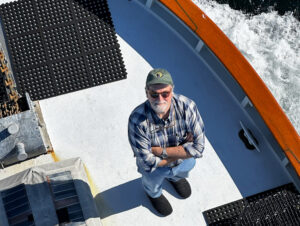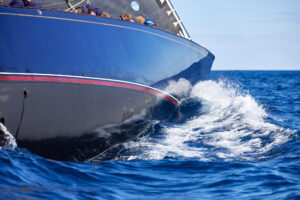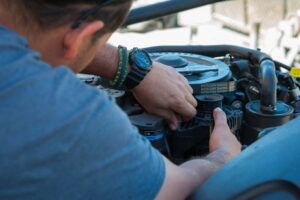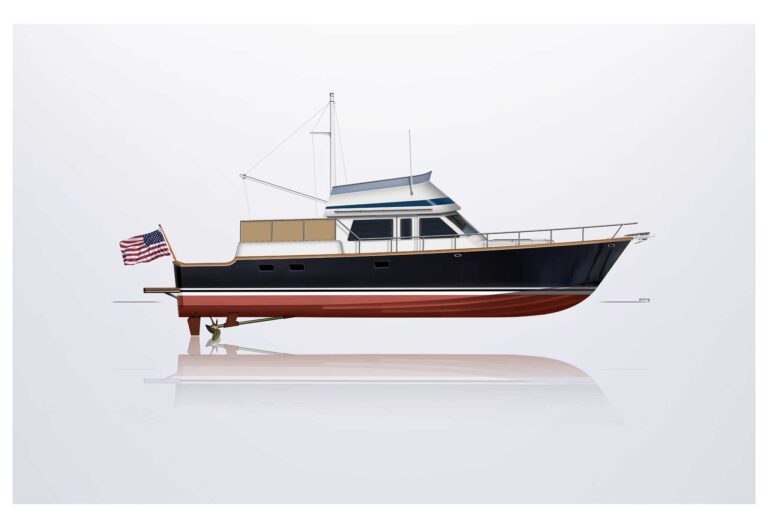Solar panels provide a clean, quiet, and sustainable energy source. A well-designed solar system ensures your batteries stay charged and your systems run without relying on noisy generators or shore power.
In this guide we’ll tell you about the essentials of a boat solar installation. By understanding these components, you can create a tailored solar setup that meets your boat’s energy needs, reduces fuel dependency, and aligns with the growing demand for eco-conscious marine solutions.
Charge Controllers
A charge controller is a critical component of any solar installation, ensuring that the voltage from your solar panels is safely and efficiently converted to match your battery bank’s charging profile. There is a significant performance difference between the two leading charge controller types.
MPPT (Maximum Power Point Tracking) controllers are widely regarded as the superior option for solar charging, especially on boats where space for solar panels is limited. These controllers step down the voltage from the panels while boosting the output amperage, achieving impressive efficiency levels of 94 to 97 percent. Though MPPT controllers come at a higher cost, the benefits often outweigh the expense. Many MPPT controllers also include advanced features like Bluetooth connectivity, enabling real-time monitoring of your solar output.
PWM (Pulse Width Modulation) controllers, often found in budget-friendly solar kits, are simpler but less efficient. These controllers regulate voltage by pulsing power from the solar panels to the battery bank, using the time in between to average out to the charge voltage. However, this method can result in significant energy loss, with efficiency as low as 50 percent of the solar array’s potential output.
While they are inexpensive, PWM controllers are not suitable for marine use due to their lower performance and concerns over build quality. Poorly made PWM controllers can sometimes fail to regulate voltage properly, risking overcharging and potential damage to batteries. For most boaters, investing in an MPPT controller is not only safer, but a more efficient choice for meeting on-the-water energy demands.
Making Connections
How you connect your solar panels plays a significant role in the system’s efficiency and overall output. Each wiring configuration has its advantages, but the right choice depends on your solar array size, potential panel shading and charger/wiring limitations.
Parallel Connections: In a parallel configuration, the positive leads of all panels are connected together, as are the negative leads, typically using branch parallel adapters. This setup is particularly effective for boats, as shading on one panel has minimal impact on the overall efficiency of the array, unlike in a series configuration, where shading can significantly reduce output.
When calculating the electrical properties of a parallel array, the voltage of the panels remains constant, while the amperage increases with each additional panel. This increase in amperage can present challenges, as most standard solar connectors and 10-gauge solar wires are rated for a maximum of 30 amps. This limitation restricts the number of panels that can be safely connected in parallel without upgrading to thicker wires or higher-rated connectors.
Series Connections: When solar panels are connected in series, the voltages of each panel are added together, while the amperage remains the same. This configuration is ideal for larger solar arrays not subject to shading, as the solar connectors and wire will be able to handle a high overall wattage output when compared to a parallel array.
However, it is critical to understand that if one panel is shaded or damaged, the output of the entire array drops.
Individually Regulated Setups: An alternative to series and parallel configurations is using individual charge controllers for each panel. This setup prevents overloading of connectors and wires, common in parallel arrays, and offers redundancy if panels are shaded. However, it requires running additional wires (two per panel) and comes with the added cost of extra charge controllers.
Additional Components
In addition to selecting the solar panels, charge controller, and the wire configuration, choosing the proper components to complete this installation is important.
Solar Wire: Solar wire comes in various insulation types, with PV wire being the preferred option because it uses stranded tinned conductors. Followed by PV wire, USE-2 is also a good recommendation, providing additional UV protection and chafe resistance. Standard marine wire should not be used because it has thinner insulation and a higher possibility of water intrusion into the connectors.
MC4 Connectors: MC4 connectors are a specialized connector designed specifically for solar panel systems and provide a watertight locking connection suitable for the outdoor environment. These connectors can be self-installed but require a special crimper to ensure proper installation. Failure to properly crimp these connectors can lead to additional resistance and, in extreme situations, result in fire. MC4 connectors should be selected based on the wire gauge being used. Note: They are typically rated for up to 30 amps of current.
Solar Fusing: Just like any other electrical system, proper fusing is an absolute requirement for marine solar systems. It not only protects against chafe and short circuits, but also protects against possible fires from a fault panel. Proper fusing for solar systems starts at the battery, where the fuse is selected for the wire gauge used to connect to the solar controller.
On parallel systems, when the short circuit current of the entire array is greater than the maximum series rating listed on the panel, fuses must be installed on all parallel branches, and they must be sized to the maximum series fuse rating. When this is not the case, individual panel fuses are not required but they should still have a dual pole solar disconnect below deck. Although not listed in ABYC code, these requirements are considered a best practice.
Note, the cheaper dual pole disconnects tend to have a higher likelihood of internal failure. This is why we typically opt for rotary disconnects, or DIN mount fuse systems, which allow for easy disconnection of each pole.
Power Optimizers: Power optimizers are designed to maximize each panel in a series configuration and are typically reserved for the commercial or home installation. With a high failure rate, the benefits are not worth the risk when installed on a boat and should be avoided.

Mounting Options
There are multiple mounting options available for boats, and the preferred method depends on the boat type, wattage requirements and aesthetic concerns.
Canvas Solar Integration: Integrating semi-flexible solar panels into canvas dodgers and Biminis is a great way to add solar while not affecting the boat’s lines or appeal from afar. With this mounting style, panel dimensions are typically the greatest concern, as many arrangements require some Tetris skills to meet the minimum required wattage for running a refrigerator.
When securing panels onto canvas, it’s important to ensure that the panels are secured with Velcro or zippers, and the canvas is protected from chafe. Some boaters have used rare earth magnets to secure solar panels on canvas, but high-wind events can cause failure.
Deck-Mounted Panels: Semi-flexible panels can be walked on, which makes them a great option for deck mounting. For deck applications, choose textured semi-flexible panels that have underside-mounted diode boxes. These panels provide better grip, eliminate extrusions that can jam a toe or cause a trip, and eliminate on-deck wiring. These panels do require routing into the deck to make space for the diode box and wires, and because they are attached with marine sealant, you should purchase premium solar panels to ensure maximum lifespan.
Rigid panels can also be deck mounted, and on powerboats with a large amount of additional real estate, they can be a great option due to their lower cost and longer lifespan. Rigid panels require mounting feet to secure to the deck and cable clams for waterproof cable pass through. This option is best reserved for large unobstructed hardtops that can accommodate a 400-watt-plus sized panel and gets no foot traffic.
Davits/Arches: Typically reserved for sailboats, davits and arches are a great location to install rigid panels. Although this type of installation will affect the lines and aesthetics of your boat, it will provide a premium location with lower risks of shading.
This option has the potential to protect your dinghy from the sun, as well as provide shade in the cockpit. If you’re planning to install solar on your davits, be sure to take the panel height into account when using your stern ladder. Your stern pulpit may also need reinforcing to handle the additional load.
Lifelines Wing Mounts: Typically reserved for sailboats, mounting solar panels on your lifeline is a great option when trying to optimize every last inch for maximum solar output. This method typically involves installing a stainless rail between stanchions and a rigid panel.
For boaters looking for a lighter option, LightLeaf Solar manufactures an adjustable panel stabilized with carbon fiber.
Mike Garretson owns Sea & Land Yacht Works in Wakefield, Rhode Island. This story was published in the February 2025 issue of Soundings magazine.
February 2025










